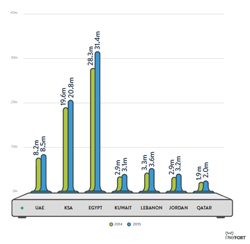The Arab world is buzzing with potential for ecommerce and retail players, and early entrants are looking forward to gain the first mover advantage. To give you a lead on the competition, we’ve got all the stats on the buyer profile in the Middle East countries from Payfort’s State of Payments 2016 report compiled here.
Ecommerce companies and retailers can use these facts and numbers to strategize accordingly for better outcomes.
Population distribution in the Middle East

The largest population centers, and therefore the biggest opportunity hubs, are the Kingdom of Saudi Arabia (KSA) and Egypt.
- Mobile web is fast becoming the platform of choice in Saudi Arabia for browsing webstores. But as almost half the population is unsure of online payment security, businesses need to communicate their security features better to earn trust.
- About 3 out of 4 shoppers in Egypt browse and purchase on the desktop, but 40% claim to be hindered by the need for a credit card.
Overall population growth in the Middle East countries since 2014 has been 2.1%
Internet users in the Arab countries

The rate of growth of the number of internet users in the Arab countries has been rapid – 13.1% in 2015.
- Egypt has the largest number of internet users in the region, followed by Saudi Arabia and Morocco; these constitute 3/4th of the region’s share.
- Yet, internet penetration is low: 35% in Egypt and 65% in Saudi Arabia.
Growth of Online/ecommerce buyers in the Middle East

The number of people buying online in the Middle East increased by 14% in 2015.
- 18 million people shop online in Egypt. Yet, this is only a small proportion of the country’s population.
- 70% of UAE’s population shops online.
- In Kuwait, the highest percent of internet users shop online: 82%.
Social media usage patterns in Middle East

About 100 million people, or 85-90% of the population, in the Middle East use social media daily.
- Facebook is the platform of choice, but is less favoured in Saudi Arabia and Kuwait.
- Pinterest is fast gaining popularity across countries in the region, especially Qatar.
Gender

Overall, men tend to shop online more than women in the Arab countries.
- In Egypt, men constitute 80% of online shoppers.
- The UAE shows greater representation of women at 40% of online shoppers.
Age group

A significant portion of the ecommerce market in the Middle East comprises people in the 30-34 year age group.
Two outliers to take note of:
- In Saudi Arabia, Lebanon and Egypt, the 18-25 age group is active in online shopping.
- Qatar has a large section of keen online shoppers who are over 40.
Income levels of the online buyers from the Middle East
A large section of the population in Qatar, the UAE, Lebanon, Saudi Arabia and Kuwait falls in the higher income brackets.
- Egypt and Jordan are the exceptions to this – majority of their population is in the lower income section.
What is consumer demographics?
Consumer demographics is a statistical view of a population, generally including age, gender, income, schooling, occupation and so on.
Understanding the demographics of your target customers is critical for the success of your business. This data enables you to decide exactly what your product and services mixes will include, and will also affect pricing, packaging, promotion and place.
Adapted from Entrepreneur.com



